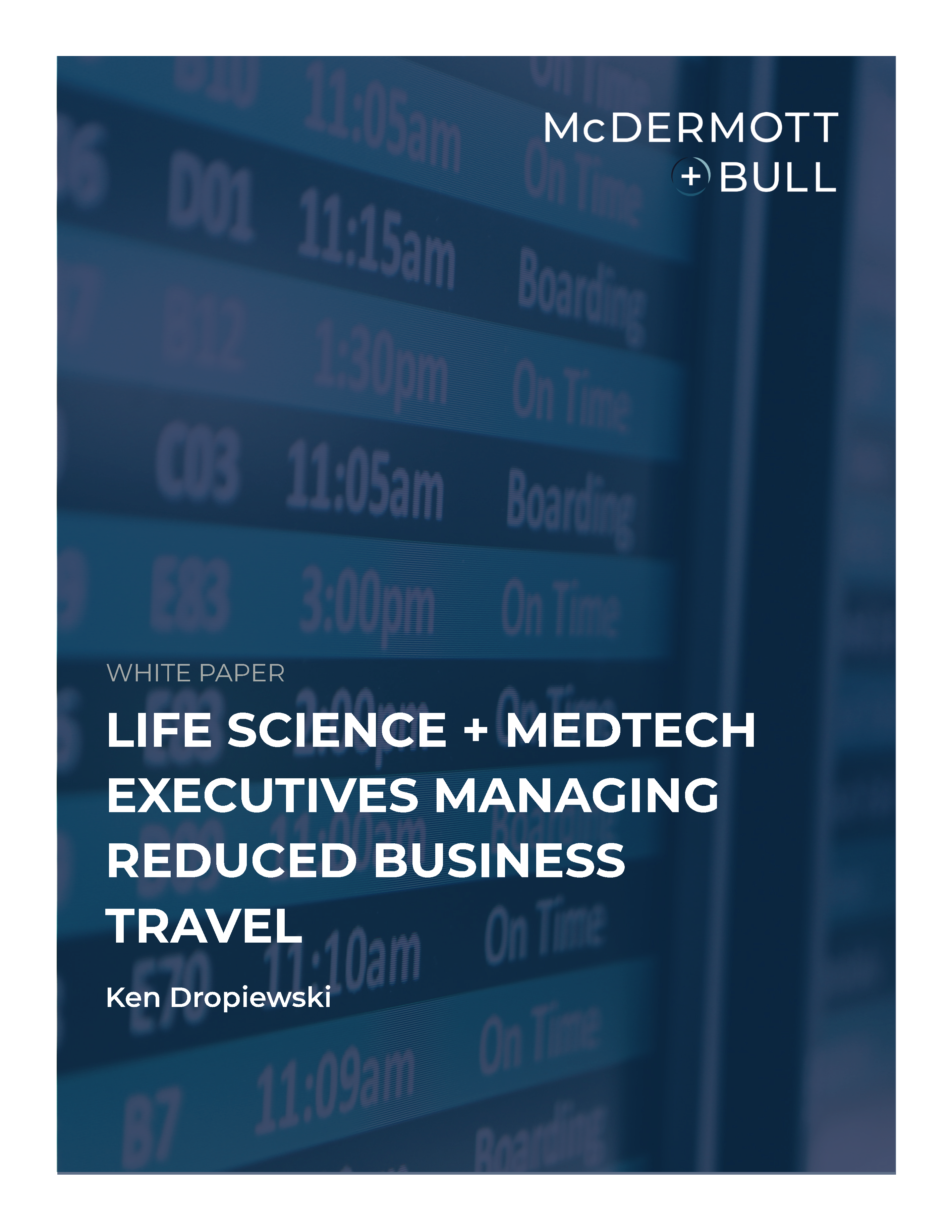THE NEW NORMAL: WHAT BUSINESS TRAVEL WILL LOOK LIKE FOR EXECUTIVES
Over the past six months, I’ve had the opportunity to speak with executives in the life science and medtech space about the reduction in business travel due to the pandemic. We talked about what it has been like for them over the past year, what it has impacted in their work, and what they expect it to mean for the future of the industry.
Some executives haven’t traveled for business since the pandemic first hit. Others have, but in a reduced capacity. Although travel altogether is down, along with the exhaustion from travel itself, most say they are more tired now than they were in previous years. This is mostly because it is so much more convenient — and expected — to sit down, grind out work, and participate in video meetings. The assumption is that you are available to act. The excuse “Sorry, I’ll be out of pocket traveling” is no longer viable. However, when talking about resuming business travel, almost all of the executives I talked with said they are looking forward to getting back on the road more regularly, but they assume it will be less frequent than before.
DO EXECUTIVES FEEL MORE PRODUCTIVE WITH REDUCED TRAVEL?
From my conversations, the conclusion was that sitting down and pushing out more work seems ideal, but it doesn’t always correlate with higher productivity. For example, the work you’re producing may get passed down to individuals who have less bandwidth or resources due to cutbacks in their team. In turn, they may not have the capacity to take on a more strenuous workload and may delay the completion of projects. Alternatively, maybe meetings are taking away from your productivity. As virtual meetings gained traction, maybe they became more about trying to keep in front of your team than about you really needing to be there. There might be ways to decrease meeting time to increase productivity and gain some time back in your day. It is important to show that you are around and available, but it is also important to offset the amount of time given to meetings.
During these conversations with industry leaders, I started surveying what they miss from the way it used to be, in addition to the way they have adapted and the strategies they’ve employed to maintain success in the current work environment. Here are some highlights:
#1
______________________________________________
NETWORKING

They miss opportunistic networking that used to come from attending conferences. They miss the practice of constant networking. One executive I spoke with said he is intentional about setting up one to two meetings a month with people who may not have immediate business needs, but who he enjoys running into on occasion. They’re still in the same business circles, but nothing more is expected than taking a breather to connect with those you may not see as much, if at all, because of the new normal.
#2
______________________________________________
DOWNTIME

They miss the “downtime” of traveling. We all remember the times that we traveled a day and half for a two-hour meeting. When working from home, you always have to be camera ready for meetings. One executive I spoke with started putting Do Not Schedule (DNS) on his calendar to create some space that had been lost. While this strategy may not give you all the time back that was lost, it will give you some breathing room.
#3
______________________________________________
SUPPORT

Capitalize on administrative support. Having a strong admin partner goes a long way, but the way you view the role may seem different now. Many executives I spoke with said that they really lean on their admins to guard their time and take on some of their burden. It’s an easy trap for executives who are working remotely to respond to messages as they come in, forgetting their admins are still there to support them. Utilize the support the same way you always have.
#4
______________________________________________
QUALITY V. QUANTITY

Take quality over quantity. Gone are the days where someone is expected to be in person at every meeting. Recent events have proven that business can move along whether it is in person or not. Meetings and conferences that were fighting for relevancy in the past may struggle as things open back up and companies become more selective with the events they attend. Every executive I spoke with said they are looking forward to getting back out there, but they will be more selective on where and when to travel.
As we slowly adjust back to in-person meetings, conferences, and events, it is important to remember these key takeaways to ensure that you make the best use of your time and resources. We have learned a lot in adjusting to a remote work environment, and we can use that experience to propel us into success, continue to grow, and maintain balance at work.
About the Author
Ken Dropiewski
Managing Director
dropiewski@mbexec.com
Ken Dropiewski is a Managing Director with McDermott + Bull’s Life Science and Healthcare Practice and has been doing search for nearly two decades. His expertise serves the medical device, biotechnology, and healthcare industry. Ken is especially known for work done in the cardiac, vascular, interventional, and oncology segments and has been in the MedTech field for 30 years. Prior to his career in search, he spent time at Johnson + Johnson and Boston Scientific.



